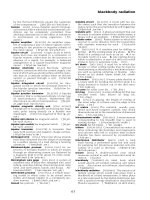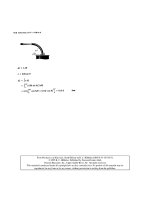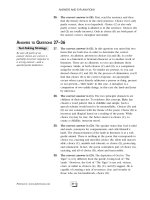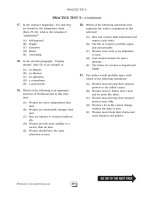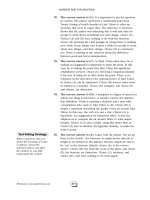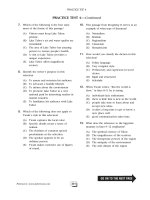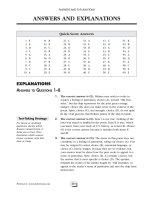SAT II success literature Episode 1 Part 4 doc
Bạn đang xem bản rút gọn của tài liệu. Xem và tải ngay bản đầy đủ của tài liệu tại đây (91.46 KB, 20 trang )
58. The correct answer is (D). You might argue that Puck appears
to be somewhat menacing and overbearing, choice (E), or that
the fairy appreciated Puck’s talents, choice (A). However, you
are asked about the tone of the passage, not the mood of the
speakers. Tones of belligerence and contentiousness, choice (B),
or compassion and love, choice (C), are not supported in the
passage. The overall tone is amusing and lighthearted, yet
informative, choice (D).
59. The correct answer is (C). While there is an element of
admiration, choice (E), in the fairy’s speech, words like knavish,
frights, and Hobgoblin indicate censure on the part of the fairy.
Only choice (C) fits this attitude. Choice (A), envious; choice
(B), overwhelmed; and choice (D), joyful are not supported by
the text.
Test-Taking Strategy
Sometimes reading the words
around a reference will help
you figure out what the cited
word or phrase means.
60. The correct answer is (C). The punctuation, a semicolon
ending an independent clause, and logic—horses do not have
bowls—tell you that choice (A) is incorrect. While ale is
mentioned, the gossip is drinking it, not serving it, so a bar-
keeper, choice (B), is an illogical synonym. The word telltale,
choice (D), is a synonym for gossip, but it does not explain who
the person is. A fairy, choice (E), is illogical, because Puck has
not mentioned playing tricks on individuals in the magical
world. The most appropriate synonym, an old woman, choice
(C), is indicated by the feminine pronouns and the phrase
“withered dewlap.” Even if you did not know that dewlap
means loose neck skin, withered offers a clue about age.
ANSWERS AND EXPLANATIONS
51Peterson’s: www.petersons.com
Chapter 1
STRATEGIES FOR THE SAT II:
LITERATURE TEST
This chapter provides some basic information about the SAT II:
Literature Test as well as offers some general strategies that will help
you when taking the test. Chapters 2 and 3 will give you specific,
effective techniques for answering the different types of multiple-
choice questions that are asked.
You have answered hundreds, probably thousands, of multiple-
choice items during your time in school. The multiple-choice ques-
tions on the SAT II: Literature Test really are not that different. Of
course, there is a great deal riding on this SAT II test, but just like
other standardized tests, if you have studied and you know some
test-taking techniques, you can do well.
PRACTICE PLAN
Study Strategy
Keep a dictionary with you
as you review.
Chapter 1 presents some general strategies for taking the SAT II:
Literature Test and some special techniques for reading and analyzing
literature that will enable you to score your highest. In Chapter 2,
you will work on strategies for answering multiple-choice questions
on prose. Chapter 3 focuses on poetry questions. Both chapters will
give you many opportunities to practice what you are learning.
Use the Diagnostic Test and Practice Test I as tools to improve
your objective test-taking skills. Use the techniques explained in this
chapter and in Chapters 2 and 3 to practice answering questions on
selections of prose and poetry. Correct your responses with the
Quick-Score Answers provided for each test. If you do not understand
why an answer is correct, refer to the explanations given after the
Quick-Score Answers. It is a good idea to read the answer explana-
tions to all the questions because you may find ideas or tips that will
help you better analyze questions and responses in the next Practice
Test you take.
53Peterson’s: www.petersons.com
After you have finished reviewing all the answers, identify your
weak points and plan what you can do to improve. Review the
strategies in this chapter and the techniques presented in the
following chapters. Then take the next Practice Test, remembering to
• apply the test-taking system with care.
• work to give more correct responses.
• strive to answer more questions in the 60 minutes.
By how much did you improve your score?
BASIC INFORMATION ABOUT THE SAT II:
LITERATURE TEST
1. The SAT II: Literature Test consists of approximately 60 multiple-
choice questions. You are given five possible answers for each
question.
2. The test generally has six to eight selections about evenly divided
between poetry and prose. Each selection has from four to
twelve questions.
3. You will have 60 minutes to answer all of the questions.
4. There are three forms of multiple-choice questions:
• Regular multiple-choice questions that are either questions
to answer or sentences to complete and that require you
to determine the best or most accurate response from
among five choices
• NOT/EXCEPT questions that ask you to decide which of
the five choices is inaccurate in the context of the
selection
• Roman numeral questions that are tiered, or multistep, in
operation and ask you first to establish which of the
Roman numeral item(s) is correct and then which of the
five answer choices corresponds to that decision
SAT II SUCCESS: LITERATURE
54 Peterson’s SAT II Success: Literature
5. American literature provides approximately 40 to 50 percent of
the selections in the test, with English literature providing the
remainder. Occasionally some other original English-language
selection may be used. The College Board lists the break down of
percentage of questions by time period as
• 30 percent based on literature of the Renaissance and
seventeenth century,
• 30 percent based on literature of the eighteenth and
nineteenth centuries, and
• 40 percent based on literature of the twentieth century.
6. Generally you will find 45 to 50 percent of the selections to be
prose and 45 to 50 percent poetry. There may also be drama on
any given test.
7. Questions usually ask about the following:
• meaning—the major points, arguments, themes, and ideas
that the writer conveys to readers
• form—the structure, genre, and method of organization
the writer uses; its purpose and its effect
• tone—the writer’s attitude toward the subject, characters,
and audience
• narrative voice—whether the speaker is the same as the
writer, the speaker’s attitude toward the subject or the
characters
• style—the writer’s way of writing things, including
arrangement of ideas, word choice, imagery, rhythm, and
repetition
• characters and characterization—characters’ distinguishing
traits as well as the techniques the writer uses to develop
the characters
• meanings in context—the meaning of specific words,
phrases, or lines in a selection
8. You receive one point for each correct answer you give, and you
receive no points for each question you leave blank. If you
answer incorrectly, a quarter of a point is deducted. This is the
guessing penalty.
9. You can answer some combination of answers correctly and
leave some questions blank and still get a good score.
CHAPTER 1: STRATEGIES FOR THE SAT II: LITERATURE TEST
55Peterson’s: www.petersons.com
APPLYING THE TEST-TAKING SYSTEM
Besides the obvious importance of understanding the material, you
have probably discovered during your educational career that there
are three significant considerations when taking multiple-choice tests:
• Effective reading and analysis of test material
• Time management
• Intelligent guesses
If you fail to do any of the following, your score can suffer:
• If you do not read the selections or the questions skillfully,
you may make errors that are unnecessary.
• If you neglect the time, you may miss opportunities for
showing what you know.
• If you do not make educated guesses to answer questions
about which you are not positive but know something, then
you are missing out on a higher score.
How do you prevent these things from happening and ensure your
highest score? You need to develop a plan to read effectively, to
manage your time well, and to use all your knowledge to the best
possible effect.
CREATING A PLAN OF ATTACK
Consider the following steps to help you create an effective plan of
attack:
1. Pace yourself; be aware of the time.
2. Scan through the selections to decide which passage to do first
and which one to do last.
3. Read the passage, using strategies for poetry and for prose.
4. Answer the questions.
Let us examine the steps in detail.
SAT II SUCCESS: LITERATURE
56 Peterson’s SAT II Success: Literature
PACING YOURSELF
Study Strategy
Use a watch while practicing,
so you become accustomed
to the time restrictions.
The first part of the strategy for acing the test is time awareness. You
have 60 minutes to finish the test. Depending on the number of
questions, give yourself approximately 8 to 12 minutes per selection.
Use that time period as a guideline. If you find you are spending
significantly more time per section, speed up. In the unlikely event
that you finish with time to spare, revisit any problem passages again
to check your answers.
If, as the hour comes to an end, you find that you have only 5 or
so minutes and another passage to complete, try this technique. Do
not read the passage; read the questions instead. Some questions such
as those asking about vocabulary can be answered just by reading the
cited lines. Other questions ask about specific portions of the
selection and provide the line numbers for your reference. Answer
these sorts of questions when time is short.
SETTING PRIORITIES
The first active step to take is prioritizing the passages. You do not
have to do questions or passages in the order they appear on the test.
Quickly scan the passages to find which ones seem difficult to you
and which seem easy. Do the most difficult one last and the easiest
one first. Since many students only finish five or six passages, you
will score more points by answering what you are most comfortable
with and leaving the most difficult for last.
READING ACTIVELY: EFFECTIVE STRATEGIES FOR PROSE
AND POETRY
This step is obvious—read the selections. To be able to answer
questions about literature, you must be able to read carefully and
critically. Obviously, a casual reading of a selection may provide an
unreliable or uncertain response that will not be correct.
You will be reading in a test situation. You must answer
questions on the material. However, you do not need to memorize
the passage or retain the content for long. For all passages, whether
they are poetry or prose, first skim the passage to get a general idea
of the major ideas and the writer’s purpose in writing.
CHAPTER 1: STRATEGIES FOR THE SAT II: LITERATURE TEST
57Peterson’s: www.petersons.com
READING PROSE PASSAGES
Test-Taking Strategy
To ensure that you don’t
miss important words, ideas,
and details, underline, circle,
or put brackets around key
information as you read.
Begin by scanning the selection. Take only 30 or so seconds to do so.
You want an overview here; don’t worry about details. Then concen-
trate and read the selection carefully. Read for a clear, specific
understanding of the writer’s main idea. The main idea is the underly-
ing communication that the writer is trying to make. It is not details,
but the fundamental message you, the reader, are to receive. Ask
yourself what the author’s purpose is in writing and what is revealed
about the subject. Be aware of your reactions to the piece. Make
predictions about conclusions. Mentally summarize important points
and supporting details.
You probably won’t find a topic sentence or a literal thesis
statement in the test selections. You will need to interpret the
literature to find the theme of the passage.
READING POETRY PASSAGES
Test-Taking Strategy
As you read, get in the habit
of marking what you
consider key phrases, lines,
imagery, and figurative
language.
Poetry’s special requirements call for some techniques that are
different from those for reading other literature. First, skim the poem.
Then read it carefully and slowly several times, but do not read the
poem line by line. Read it sentence by sentence and then phrase by
phrase, paying attention to the punctuation. Ask yourself what the
poet seems to be saying to you and question the meaning of the
language and the impact of the images.
Then read the poem again. On the second reading, be aware of
the effect the poem has on you. Listen to the musical qualities, the
rhythm, and the rhyme. Pause to summarize where appropriate, even
paraphrase mentally. Pull the details together to understand the
meaning.
If you still do not understand the poem, do not spend any more
time on it. Some unintelligible phrases—or even a line or two—will
not make that much difference in your total score.
SAT II SUCCESS: LITERATURE
58 Peterson’s SAT II Success: Literature
ATTACKING THE QUESTIONS: PRACTICAL ADVICE
When you take the SAT II: Literature Test, you will want to have
every advantage possible. Of course, the ideal is to know the correct
answer as soon as you read the question, but that does not always
happen. Here are some methods to help you score well.
Test-Taking Strategy
Be sure to skip ovals on the
answer sheet when you skip
questions on the test.
• You do not have to do anything on the exam in the order it is
presented. You can and should tackle the selections and then
answer the questions under a selection in the order that
works for you. By showing yourself that you know answers,
you build self-confidence.
• Remember that you can return to the passage to find answers
that you do not immediately recall. Often the question will
include line numbers for reference. If not, scan to find the
information you need to answer a question.
• When a question asks for the contextual meaning of a word,
substitute the answer choices in the sentence. Always read the
lines around the cited word for the context.
One technique that is especially helpful for achieving your best score
is the process of elimination. Use this technique when you do not
know the correct answer immediately.
• First, ignore answers that are obviously wrong.
• Discard choices in which part of the response is incorrect.
• Revisit remaining answers to discover which seems more
correct. Remember to eliminate anything that is wrong.
• Choose the answer you feel is right. Trust yourself. Your
subconscious usually will guide you to the correct choice. Do
not argue with yourself.
CHAPTER 1: STRATEGIES FOR THE SAT II: LITERATURE TEST
59Peterson’s: www.petersons.com
ANALYZING THE QUESTIONS: STRATEGIES
FOR DETERMINING ANSWERS
Many times, the key to finding the correct answer is to narrow down
the choices and to make an educated guess. Eliminate some answers
by finding those that are obviously unrelated, illogical, or incorrect.
Having reduced the number of choices, you can make an educated
guess from among the remaining possibilities. Use the techniques
presented in the chart below to reduce the number of choices.
Strategies for Answering Objective Questions/
Making Educated Guesses
Answer Choice Reason to Eliminate
1. too narrow too small a section of the selection
covered, based on the question
2. too broad an area wider than the selection covered,
based on the question
3. irrelevant • nothing to do with the passage
• relevant to the selection but not the
question
4. incorrect • distortion of the facts in the selection
• contradiction of the facts in the
selection
5. illogical • not supported by facts in the passage
• not supported by cited passage from the
selection
6. similar choices GO BACK AND REVIEW 1–5 TO TEASE
OUT THE DIFFERENCES.
7. not/except answers that correctly represent the
selection
SAT II SUCCESS: LITERATURE
60 Peterson’s SAT II Success: Literature
The not/except questions are tricky. As you go through each answer,
ask yourself, “Is this statement true about the selection?” If yes, cross
it out, and keep going until you find a choice that you can answer
“no” to.
Recognize that if you use the strategies for answering multiple-
choice questions coupled with educated guessing, your chances of
scoring higher are excellent. You will have to answer wrong four
times to lose a single point. Practice these strategies when you take
the Practice Test, and using them on test day will be second nature
to you.
CHAPTER 1: STRATEGIES FOR THE SAT II: LITERATURE TEST
61Peterson’s: www.petersons.com
Chapter 2
ELEMENTS OF PROSE
On the SAT II: Literature Test, you will discover that most of the
multiple-choice questions test how carefully you read and how well
you interpret what you read—whether it be prose or poetry. Chapter
2 presents a quick review of prose and techniques that you can apply
to the questions about prose selections. Most of the selections are
short. Some may be from plays, others may have come from short
stories, and still others may be taken from essays. By following the
suggestions offered in this chapter, you may gain those extra points
that will give you a great score.
WHAT THE SAT II: LITERATURE TEST COVERS
You will find questions on the SAT II: Literature Test that ask about:
• Meaning
• Form
• Tone
• Narrative voice
• Style
• Characters and characterization
• Meanings in context
Questions about words or phrases in context are basically vocabulary
questions about difficult words in a passage or about ordinary words
or phrases used in an unusual way. Contextual questions are covered
at length in Chapter 3. This chapter will take you through the other
categories to help you understand what questions may be asked and
what to look for in the answer choices.
63Peterson’s: www.petersons.com
DISTINGUISHING FICTION AND NONFICTION
Selections on the test may be prose, poetry, or drama. Prose works
fall into two categories, or genres, fiction and nonfiction. More
specifically, narrative fiction is a made-up account of a series of
events, although sometimes the fiction may be wrapped around
historical incidents. Works of narrative fiction usually focus on one or
more major characters who change as they experience conflicts or
meet others. The most common genres, or subcategories, of narrative
fiction are the following:
• Short story
• Novel
• Novella
Nonfiction prose refers to forms such as essays and articles. Essays
and articles express ideas, interpretations, and descriptions. Their
topics may be social, political, artistic, or scientific. An essay explores
its topic thoroughly, but not extensively, and may express the
writer’s personal views. A writer may choose to enlarge the scope of
a topic more exhaustively in a book.
Articles, similar in form to essays, explore and draw conclusions
from facts and are sometimes solely factual, that is, the writer uses an
objective point of view. When an article combines research findings
with conclusions, the style is similar to an essay. When an article
simply reports research, the style is less similar. As with an essay, an
article’s subject may be more exhaustively presented in book form.
Common forms of nonfiction are the following:
• Essay—formal and informal
• Informational article
• Biography
• Autobiography
• Criticism
• Informational book
SAT II SUCCESS: LITERATURE
64 Peterson’s SAT II Success: Literature
MEANING AND MESSAGE
Meaning is conveyed through the theme, the central or dominating
idea, of a work. In fiction, meaning derives from an abstract concept
that becomes concrete through its representation in person, action,
and image. The subject, or topic, of the work indicates the idea or
group of ideas with which the writer is dealing. Some often-used
topics are
• Love
• Sacrifice
• Justice
• Right and good
• The nature of evil
• Honor
• Growth
• Persecution
• Power
• Survival
The topic alone will not tell you the theme or provide meaning,
however. As the reader, you must look for the assertion that the
writer is making in the story. Thus, a short story may assert that love
is painful, power destroys ethics, or evil exists in everyone.
MEANING IN FICTION
When analyzing a work of fiction for meaning, you will find the
answer is usually in the form of a principle about human nature,
conduct, or motivation. Keep in mind that the main idea or concept
pervades a work, and most things happen only because they have
bearing on the meaning. Look at actions, characters, statements,
symbols, and dialogue in terms of how closely they relate to the
theme. To crystallize the theme, or meaning, in your mind, ask
yourself what the story says about the topic and answer with a
complete sentence.
To find the main idea or theme in a work of fiction, consider
the following methods that writers use to convey meaning:
• The work itself as it represents ideas
One of the most important ways through which a writer may
communicate theme and meaning to the reader is to make the
ideas inseparable from the total impression of the work. All
events and all characters create an idea that is made powerful
by the impact of the work itself. In a case like this, the
meaning becomes clear after you finish reading.
CHAPTER 2: ELEMENTS OF PROSE
65Peterson’s: www.petersons.com
• Direct statements by an unnamed speaker
An unnamed speaker, who may or may not represent the
writer’s exact views, states ideas directly through commentary
that is to serve as a guide for your reading or as a way to
deepen your understanding. Consider such ideas along with
other statements expressed in the work to aid in your
understanding of a story.
• Direct statements by the persona
In many works, first-person narrators tell you, the reader, their
own ideas. Often these characters may be expressing thoughts
that are identical to those of the writer, but not always.
Carefully consider to what extent the narrator’s ideas are
equivalent to the writer’s. The author may be using the
persona to examine ideas, to show the character’s limited
understanding of a situation, or to express thoughts that are
directly opposed to the writer’s true position.
• Dramatic statements made by characters
In many works, different characters express ideas that are in
conflict with one another. In this case be aware that authors
may present several points of view and leave you to choose
which is best. The author may use the characters to provide
guidelines for your interpretations. For example, admirable
characters may express ideas that the author is promoting,
while unpleasant characters may be used as a mouthpiece for
the opposite position.
• Characters who stand for ideas
In many cases, writers use characters who are involved in the
plot to symbolize an idea or value. Likewise, two opposing or
conflicting characters may stand for ideas the writer wants
you to compare or contrast.
• Figurative language
Writers may use figurative language—imagery, figures of
speech, figures of sound—to express or reinforce their ideas.
SAT II SUCCESS: LITERATURE
66 Peterson’s SAT II Success: Literature
Symbolism
Writers also use symbolism and allegory to extend meaning. A symbol
is an object, person, or event that represents something else, thus
creating meaning greater and more complex than itself. A writer may
use a symbol to make a point, to create a mood, or to intensify the
theme.
Symbols may be cultural or universal, embodying ideas or
feelings writers and readers share through their social and cultural
heritage. Biblical and mythological symbols are examples of this type
of symbol.
Private, authorial, and contextual symbols result when a symbol
gains meaning from the context of a specific work. To determine
whether something is symbolic, judge its total significance in a story.
Decide if it is of major importance with a scope and sustained
reference beyond itself. In other words, does the person, object, or
event stand for something else?
Allegory
An allegory is a story intended to be read on a symbolic level. It is a
complete, self-contained narrative, but it also signifies another set of
events or a condition of life. Writers use allegories to entertain and
instruct at the same time, that is, to offer a moral lesson in a palatable
form. Three forms of allegory are fable, parable, and myth.
• A fable is a short story that teaches a moral; it usually features
animals with human characteristics.
• A parable is a short, simple allegory often associated with Jesus.
• A myth is a story that teaches the social and cultural values of
a society.
CHAPTER 2: ELEMENTS OF PROSE
67Peterson’s: www.petersons.com
MEANING IN NONFICTION
In nonfiction, the meaning or theme evolves from the writer’s
position on the topic of discussion, that is, the writer’s thesis. For
example, a writer’s topic might be television and the thesis, “Televi-
sion conveys important cultural values.” The thesis, often found in
the introductory paragraph, may be directly stated or it may be
implied. How the writer develops the thesis results from the writer’s
purpose. The following are four types of purpose for nonfiction. They
are known as modes of discourse.
• Expository
If a writer wants to explain something by providing facts and
examples, the purpose is expository. Expository writing
defines what something is, explains how it works, or tells you
how to do something.
• Persuasive
If a writer wants to defend an opinion or course of action or
convince readers of a position on an issue, the writer’s
purpose will be persuasive. You encounter this type of writing
in editorials, speeches, book and film reviews, and
advertisements.
Sometimes a writer wants only to set out an argument
and lead the audience to conclusions based on premises and
inferences. This is known as an argument and does not go as
far as a piece of persuasion, which seeks to convince readers
with logic, reason, and facts that the writer’s view is the best
or most intelligent course of action.
• Descriptive
Descriptive writing focuses on the qualities of a person, place,
object, or experience. It records what the senses observe and
what memory recalls. This kind of writing transmits a domi-
nant impression through colorful language that describes and
elaborates. The impression is created with appeals to your
emotions, senses, and imagination and can be the strongest,
most noticeable quality of the topic or a mood, a feeling that
the topic produces. In good descriptive writing, you, the
reader, can imagine fully the topic being presented.
• Narrative
Narrative writing is used when a writer wants to capture
action. It presents a series of events to relate what happened.
Narrative writing employs language that captures both action
and sensory impressions. A narrative purpose is often found in
letters, news accounts, biographies, and autobiographies. A
hallmark of narration is chronological order.
SAT II SUCCESS: LITERATURE
68 Peterson’s SAT II Success: Literature
QUESTIONS TO HELP YOU DETERMINE MEANING
When asked to find the meaning or theme of a piece, ask yourself the
following questions:
Review Strategy
Also refer to Chapter 3 for
helpful hints on finding
meaning in poetry.
1. In which mode is the selection written? Are any other modes
present?
2. What is the writer’s purpose?
3. What effect does the work create?
4. What is the topic, thesis, or argument?
5. In a phrase, what is the work about? In a sentence, what is the
work about?
6. Are there multiple levels of meaning?
7. How does the meaning of each part contribute to the meaning of
the entire passage?
8. If the work is fiction, how do actions, settings, characters, and
language influence meaning?
FORM
Form is how a work is organized. The following sections discuss the
different forms of fiction and nonfiction. It is important to note that
some people use the word structure synonymously with form.
FORM IN FICTION
Review Strategy
See Chapter 3 for informa-
tion on form in poetry.
Fiction may be prose, poetry, or drama. This section discusses
fictional prose, although the information also applies to drama.
Fictional prose is constructed through a series of related events,
called the plot, which moves from a problem to a solution. The
actions and events usually occur in sequence, also called chronologi-
cal order, although some works of fiction make use of flashbacks.
Plot is based not only on the actions of characters but also on the
conflicting human motivations that influence the events.
The plot establishes the conflict and the consequences and devel-
opments that result. At its most basic, conflict is the opposition of two
forces. This opposition usually occurs between two people, but it can
also exist between groups or between individuals and larger forces
such as nature, ideas, and society. Sometimes, the conflict results from
a dilemma—the difficult choices—that a character faces. No matter
which type of conflict is present, it brings about responses from the
fictional characters and its outcome is in doubt because complications
always stand in the way of resolving the conflict easily. These complica-
tions produce tension and tension creates interest.
CHAPTER 2: ELEMENTS OF PROSE
69Peterson’s: www.petersons.com
How the events of a plot are arranged determines its structure
or form. Knowing the following common patterns of development
should help you in answering questions about structure and form on
the SAT II: Literature Test.
• Exposition
Exposition presents characters, their backgrounds, characteris-
tics, goals, limitations, and so forth. It lays out the situation,
including the conflict—the source of tension. While you will
almost always find exposition at the beginning of a story, it
may be found anywhere. Exposition can provide the twists,
surprises, and false steps that intrigue and interest readers.
However, at some point exposition must end and the story
proceed to a conclusion.
• Complication
Complication marks the beginning of the major conflict in the
story. The participants are the protagonist and the antagonist,
together with the values and ideas they represent.
• Crisis
The crisis is the turning point that separates what has oc-
curred previously from what will follow. Commonly, the
turning point is a decision or action that must be undertaken
in an effort to solve the conflict. Tension then builds to a
climax. Beware, though; the crisis does not always produce
the intended results.
Review Strategy
There are several subcatego-
ries of the fiction genre, and
these, in turn, have subcat-
egories.
• Novel
• Romance
• Stream of consciousness
• Mystery
• Science fiction
• Historical
• Short story
• Same as above
• Novella
• Same as above
• Myth
• Epic
• Climax
The high point of the action is called the climax, in which the
conflict and the story’s tension become most intense. The
climax makes all the rest of the action inevitable, although
such action does not necessarily occur immediately. Other
events may happen to bring the climax to a conclusion.
• Resolution or denouement
The resolution is the set of events that brings the story to its
close.
This formal structure is an ideal. In practice, the structure of most
stories will vary, although all the elements will be present. One
particular device popular with writers that alters the order of the
structure is the flashback, as noted above. It is exposition that can
occur at almost any point in a story. Mysteries also withhold exposi-
tion and postpone climaxes until the last moment to prolong the
tension and create surprise.
SAT II SUCCESS: LITERATURE
70 Peterson’s SAT II Success: Literature
